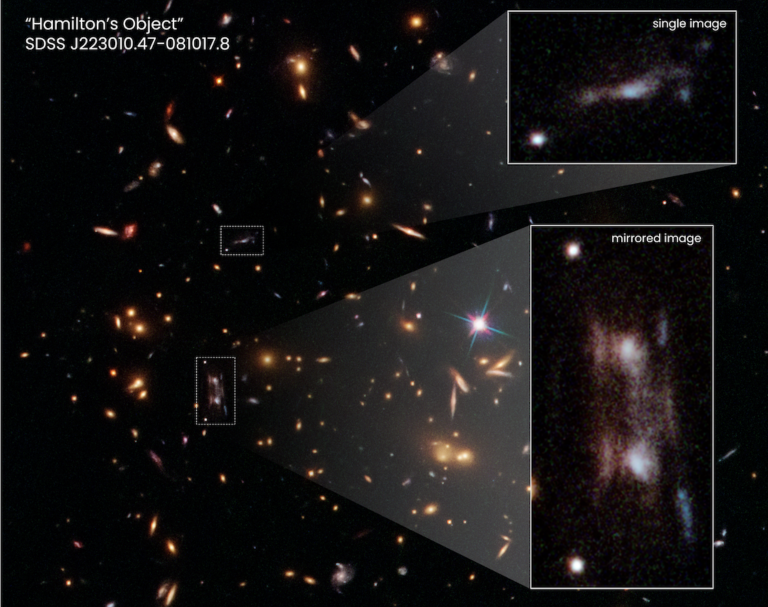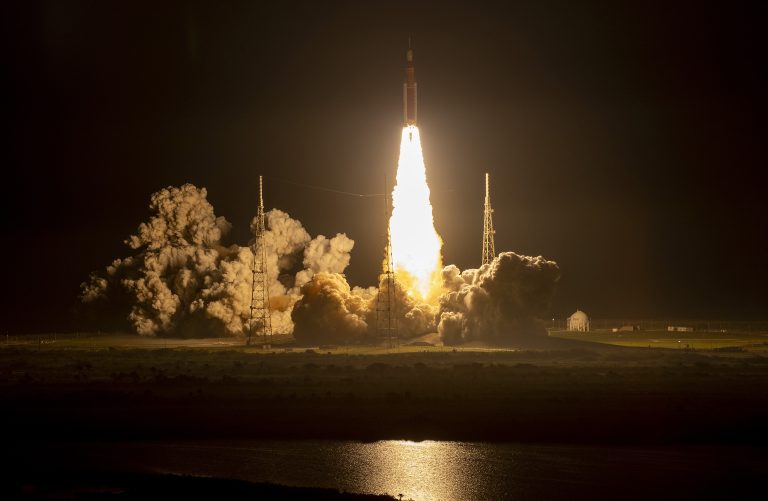A mysterious celestial object was captured by NASA’s Hubble Space Telescope that seemed to be a pair of identical galaxies. From exploding stars to colliding galaxies, astronomers have been spectators to some bizarre things across our cosmos. Although this is not the first time such a strange phenomenon was witnessed, astronomers spent years figuring out what it was.
How did it all start?
Astronomer Timothy Hamilton saw two galaxy bulges (a galaxy’s core star-filled hub) while surveying a cluster of quasars, the blazing cores of active galaxies using Hubble. This abnormal finding makes up three roughly parallel split streaks. This rare phenomenon was not well-known when Hamilton, an astronomer of Shawnee State University in Portsmouth, Ohio, discovered these unusual linear patterns by chance in 2013.
The picture of the mirrored images and parallel streaks caught Hamilton’s eyes while browsing through the quasar images. Hamilton and the rest of the squad have never seen anything like it before. “We were really stumped,” he said in NASA.
He claimed, “My first thought was that maybe they were interacting galaxies with tidally stretched-out arms. It didn’t really fit well, but I didn’t know what else to think.”
As a result, Hamilton and his crew set out to uncover the riddle. At astronomical conferences, they showed their colleagues this bizarre image. It evoked a wide range of reactions, from cosmic strings to planetary nebulae. The phenomenon was named after its discoverer, Hamilton’s Object.
What is Hamilton’s Object?
Success
You are now signed up for our newsletter
Success
Check your email to complete sign up
These linear objects that Hamilton found are the stretched images of a gravitationally magnified distant galaxy located more than 11 billion light-years away. They also seemed to be mirror copies of one another. Two of the amplified images on the bottom right pull-out on the picture are perfect duplicates of each other. As for the third image, it is shown in the pull-out at the top right. This image is the most similar to a distant galaxy situated more than 11 billion light-years away. The researchers decided that the distant galaxy looks to be an edge-on, barred spiral with continuous, clumpy star formation based on a reconstruction of this image.
When Hamilton showed the photograph of Hamilton’s Object at a NASA conference in 2015, his colleague Richard Griffiths of the University of Hawaii in Hilo provided the most logical interpretation. This was a lensing phenomenon. It is similar to those found in Hubble images of other enormous galaxy clusters, magnified images of extremely distant galaxies.
They observed that the massive gravity of a foreground cluster of galaxies was bending space, magnifying, brightening, and extending the image of a distant galaxy behind it. Although gravitational lensing causes many of these funhouse-mirror abnormalities, this Hamilton’s Object seemed particularly baffling.
Generally, astronomers studying galaxy clusters view the main cluster first, then the enlarged pictures of distant galaxies inside the cluster. However, the researchers faced difficulty since they could not pinpoint the lensing cluster.
Griffiths and his team were still unsure how to analyze the strange lensing forms since they had insufficient information about the cluster. He said, “This gravitational lens is very different from most of the lenses that were studied before by Hubble, particularly in the Hubble Frontier Fields survey of clusters. You don’t have to stare at those clusters for long to find many lenses. In this object, this is the only lens we have. And we didn’t even know about the cluster at first.”
Breakthrough in Hamilton’s Object mystery
Griffiths then consulted Jenny Wagner of the University of Heidelberg in Germany, who specializes in gravitational lensing theory. Together with her colleague Nicolas Tessore from the University of Manchester in England, she created computer software to analyze unusual lenses such as this one.
With this software, they had a breakthrough. Their software assisted the researchers in determining how the three lensed images were created. They came to the conclusion that the dark matter surrounding the stretched images had to be scattered “smoothly” across space on tiny scales.
“It’s great that we only need two mirror images in order to get the scale of how clumpy or not dark matter can be at these positions,” explained Wagner. “Here, we don’t use any lens models. We just take the observables of the multiple images and the fact they can be transformed into one another. They can be folded into one another by our method. This already gives us an idea of how smooth the dark matter needs to be at these two positions.”
According to Griffiths, this finding is significant since over a century after its discovery, astronomers still have no idea what dark matter is. He said, “We know it’s some form of matter, but we have no idea what the constituent particle is. So we don’t know how it behaves at all. We just know that it has mass and is subject to gravity. The significance of the limits of size on the clumping or smoothness is that it gives us some clues as to what the particle might be. The smaller the dark matter clumps, the more massive the particles must be.”

Solving Hamilton’s Object mystery
A natural phenomenon or a ‘trick of nature’ known as gravitational lensing produces these three enlarged pictures of a distant galaxy trapped in a cluster of galaxies. SDSS J223010.47-081017.8 is a galaxy cluster about 7 billion light-years from Earth. The massive gravity of this galaxy cluster amplifies and distorts light from the distant galaxy behind it, producing multiple images.
This unusual occurrence happens because the background galaxy straddles a ‘ripple’ in the fabric of space. The gravity of vast concentrations of dark matter (the invisible glue that makes up the majority of the universe’s mass) causes this ripple to magnify. Two mirror images, as well as a third image visible off to the side, are created as light from a distant galaxy flows through the cluster along with this ripple.
To help our ordinary brains understand, Griffith gave an example. This effect is similar to the colorful wavy patterns found on the pool’s bottom. “Think of the rippled surface of a swimming pool on a sunny day, showing patterns of bright light on the bottom of the pool,” he simplified. “These bright patterns on the bottom are caused by a similar kind of effect as gravitational lensing. The ripples on the surface act as partial lenses and focus sunlight into bright squiggly patterns on the bottom.”
In simple words, the ripple magnifies and distorts the light from the background galaxy traveling through the cluster in the gravitationally lensed distant galaxy. The ripple creates the dual copies by acting as an imperfect curving mirror.













